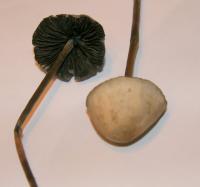whoru Posted January 19, 2008 (edited) . Edited February 12, 2008 by whoru Share this post Link to post Share on other sites
0 Hyphal Posted January 20, 2008 What were they found growing from? Was there any bluing reatin on teh stems/caps? Take a spore print as well.... But, I think you might have a mix of active and non-active Paneolus there... Share this post Link to post Share on other sites
0 Vertmorpheus Posted January 20, 2008 I'll put in an 80 percent confidence vote on the bulk being Pan/Cope cyans, with the lighter eggier looking ones maybe being last ditch fruitings in drier weather towards the end of a rainy spell... or Pan. semiovatas or something. A good rule is that if you have enough of a gut feeling to take segregated photos, you probably a> have enough to bin a few suspects and b> your liver might be more psychic than we realise haha. Sometimes in paddocks you get patches of horse and cow poo, and you find the stainers in the cow poo and the posers in the horse poo... then again some of those posers have a few academically interesting compounds in them too and I suspect sometimes both are served up on the same plate as it were for a reason ;) Prints, habitat, pics from top, side, and of the gills and we could be more helpful, but I know the precise moments my digicam decides to have a tanty so I can only assume everyone else gets the same problem lol. If you're having an impromptu hunt it can be really helpful to pinch a cap, lay it gills down on a pale leaf, anything more or less one colour really, and by the time you've finished bumbling around you can often be lucky enough to have a light print... hardly something to be stored but doing the process fixes the print into your mind. Without prints etc take all advice with a grain of salt...even though most answers will be along the same lines I am sure. VM Share this post Link to post Share on other sites
0 whoru Posted January 20, 2008 I'll put in an 80 percent confidence vote on the bulk being Pan/Cope cyans, with the lighter eggier looking ones maybe being last ditch fruitings in drier weather towards the end of a rainy spell... or Pan. semiovatas or something. A good rule is that if you have enough of a gut feeling to take segregated photos, you probably a> have enough to bin a few suspects and b> your liver might be more psychic than we realise haha. Sometimes in paddocks you get patches of horse and cow poo, and you find the stainers in the cow poo and the posers in the horse poo... then again some of those posers have a few academically interesting compounds in them too and I suspect sometimes both are served up on the same plate as it were for a reason ;)Prints, habitat, pics from top, side, and of the gills and we could be more helpful, but I know the precise moments my digicam decides to have a tanty so I can only assume everyone else gets the same problem lol. If you're having an impromptu hunt it can be really helpful to pinch a cap, lay it gills down on a pale leaf, anything more or less one colour really, and by the time you've finished bumbling around you can often be lucky enough to have a light print... hardly something to be stored but doing the process fixes the print into your mind. Without prints etc take all advice with a grain of salt...even though most answers will be along the same lines I am sure. VM Thanks for your reply guys. I should have given more of a description initially. They where picked from a cow pasture during rain. no idea how long they had been there prior to rain. The spore prints are all black. The stems all went blue. Particularly where i cut the caps off for printing. It looked like they had been dippped in blue ink. Im fairly confident they are Copelandia Cyanescens, just wanted to double check with someone more experienced. I value my internal organs. Appreciate the help thanks. Share this post Link to post Share on other sites
0 Mycot Posted January 29, 2008 (edited) It looked like they had been dippped in blue ink. If you've got a bluing reaction on these shrooms then yes you've got Copelandia cyanescens. Testing for bluing is a good test to weed out lookalikes. Edited January 29, 2008 by Mycot Share this post Link to post Share on other sites
0 paradox Posted January 29, 2008 almost 100% sure you have Panaeolus (coplandia) cyanescens there Share this post Link to post Share on other sites
0 whoru Posted February 2, 2008 Thanks for the positive ID. Big learning curve with so many species of mushroom to be found Share this post Link to post Share on other sites
.

Edited by whoruShare this post
Link to post
Share on other sites